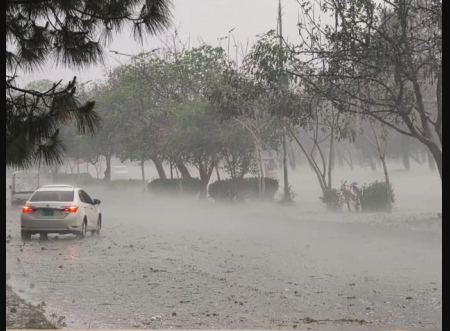Severe rainstorms accompanied by strong winds wreaked havoc across Punjab in the past 24 hours, claiming at least three lives and injuring 22 others in rain-related incidents.
The intense weather also exposed major flaws in urban infrastructure, particularly in Lahore, where heavy rainfall led to flooding, power outages, and public distress.
In Sheikhupura’s Mirza Virkan area, the collapse of a roof tragically killed two children — 2-year-old Arham and 5-year-old Haram — while two others were injured. In Vehari, roof collapses were reported in several localities including 23WB, Muslim Town Stop, 19WB, and 57WB, resulting in four injuries. One person was also hurt in Chak No. 59WB after solar panels fell during the storm.
Bhakkar’s Mankera area witnessed a wall collapse on Link Road near Hyderabad City, injuring one individual. In Dera Ghazi Khan’s PEG City, three people sustained injuries after a roof caved in.
In Attock, six family members were trapped inside their flooded home near Babu Chowk, Chungi No. 07. Rescue teams responded promptly, providing first aid and relocating the family to safety.
Lahore also saw a number of dangerous incidents. A child in the Kashmiri Gate area died from electrocution after touching an electric pole. In Harbanspura, a motorcyclist was injured due to a slippery road. Similar accidents occurred in Ali Raza Abad and Wahdat Colony, injuring two more individuals. Another person was hurt in a roof collapse on Aashiana Road, while a slip near New Ravi Bridge also left one injured.
Authorities have issued warnings advising residents to stay indoors during extreme weather and avoid flood-prone areas, as more rain and thunderstorms are forecast in the coming days.
According to WASA’s Monsoon Control Room, Lahore recorded an average rainfall of 58.8mm, with Nishtar Town receiving the highest at 84mm, followed by Lakshmi Chowk (78mm) and Paniwala Talab (74mm). The first spell of rain hit the city from 2:45am to 5:40am, followed by a heavier spell between 10:45am and 12:11pm.
The downpour crippled Lahore’s drainage system, leading to waterlogging in major areas including Jail Road (63mm), Qurtaba Chowk (68mm), and even the WASA Head Office in Gulberg (69mm). Overflowing sewage mixed with rainwater created serious public health concerns and disrupted movement across the city.
Despite claims from the Lahore Waste Management Company (LWMC) that over 6,000 waste containers had been cleared, residents reported little to no improvement. “The main roads are still submerged, and no one from the administration is here to help,” said Asif Mahmood, a shopkeeper at Lakshmi Chowk.
Low-lying areas such as Farrukhabad (49mm) and Johar Town (39mm) also remained submerged, highlighting poor drainage infrastructure.
The effects of the monsoon extended beyond Lahore, with several districts across Punjab also receiving significant rainfall: Khanewal (51mm), Rawalpindi (42mm), Sahiwal (44mm), Murree (41mm), Okara (30mm), Mandi Bahauddin (27mm), Mangla (24mm), and Toba Tek Singh (13mm). Other rain-hit regions included Gujranwala, Bahawalpur, Gujrat, Kasur, Bahawalnagar, Sargodha, Multan, and Jhang.
While the rains disrupted daily life and caused tragic accidents, they also brought a temporary drop in temperature. In Lahore, intermittent showers with lightning and strong winds provided a welcome relief from recent mugginess — though at a significant cost to public safety and urban resilience.
